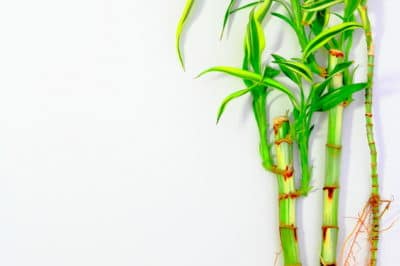Growing Lucky Bamboo
Lucky bamboo is frequently sold in a clear glass vase with pebbles, marbles or glass chips in the bottom to support and anchor the roots. It does best in bright indirect light;avoid full sun as it will burn the leaves. The plant is not submerged in the water, but the roots do grow in the water. It needs only one drop of liquid fertilizer each month.
Water for Lucky Bamboo
You shouldn’t use just any water for lucky bamboo. Rainwater is the best choice, followed by filtered water. Here’s why:
- Lucky bamboo is sensitive to chemicals used in commercial water-softening systems.
- Tap water is treated with chlorine, which can kill the plant.
- Fluoride is toxic to all dracaena, including lucky bamboo, and cannot be removed from tap water.
Growing Lucky Bamboo in Soil
Lucky bamboo actually grows better in soil, even if it isn’t as unique as growing it in water. Although it likes very moist soil, it also needs good drainage. Potting soil mixed with equal quantities of vermiculite or perlite is a good choice. You want a slightly poor soil, as lucky bamboo is very sensitive to being over-fertilized.
Repotting Lucky Bamboo in Water
Lucky bamboo will eventually outgrow its container. In the case of bamboo grown in water, repotting couldn’t be easier. Remove the plant and place in a bucket full of room temperature rainwater. Discard the water in the container and thoroughly clean the container – rinse well. Trim back the bamboo roots and tops by one-third; replace in container with fresh water.
Repotting Lucky Bamboo in Soil
As lucky bamboo grows, it may become top-heavy. A larger container that is flat and heavy can counterbalance the top growth. Water the plant well; remove it from the pot. Place in the new pot at the same level and firm soil around the roots. Provide a stake or other support if necessary. Water soil in the new container and place plant in bright indirect light.
Repotting for New Plants
An overgrown lucky bamboo can be turned into new plants. Cut the old plant into sections with at least three growth nodes. Place each section in a jar of water so only the bottom inch is actually in the water. Place in bright indirect light and change the water every three or four days. When roots appear, replant in soil if desired.
